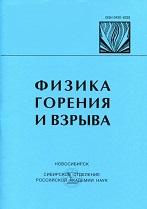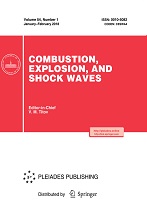|
This article is cited in 6 scientific papers (total in 6 papers)
Chemistry of combustion waves in substances with a complicated structure of reagent molecules. 1. Structure of the front of rich isopentane flame
G. I. Ksandopuloab, L. I. Kopylovaa
a Institute of Problems in Combustion, Almaty, 480012, Kazakhstan
b Research-Industrial Company "Plamya", Almaty, 480012, Kazakhstan
Abstract:
Results on the structure of the low-temperature relaxation zone of the front of a laminar Bunsen flame of iso-C$_5$Н$_{12}$ (2-methylbutane) under atmospheric pressure are presented. The flame of a premixed mixture iso-C$_5$Н$_{12}$+О$_2$+Аr with a fuel-to-air equivalence ratio of 1.7 is examined. The mass fluxes, total rates of reactions of matter consumption and expenditure, balance of substances, and profiles of bulk heat-release rates are calculated on the basis of the experimental concentration and temperature profiles. The results obtained indicate that there is a vast region of low-temperature conversion of isopentane in the flame front. It is found that only part of the products sampled by the microprobe from different points of the flame front results from transformations in the low-temperature region, namely, oxygen, isopentane, water, carbon monoxide, propane, methane, and methanol. Ethylene, propylene, hydrogen dioxide, and formaldehyde are present in the low-temperature zone in insignificant amounts; they are secondary products of conversion of methyl and propyl radicals. It is assumed that the observed feature is a result of the competing interaction of two mechanisms of fuel-mixture conversion: self-catalysis and thermal self-acceleration. Based on the previously suggested mechanism of oxidation pyrolysis by the scheme of intramolecular quadratic destruction, experimentally observed fragmentation of the isopentane molecule is demonstrated. In contrast to $n$-pentane, formation of methyl alcohol has been found in isopentane convection products.
Keywords:
monofront, bifront, oxygenated fuel molecules.
Received: 27.03.2002
Accepted: 13.04.2004
Citation:
G. I. Ksandopulo, L. I. Kopylova, “Chemistry of combustion waves in substances with a complicated structure of reagent molecules. 1. Structure of the front of rich isopentane flame”, Fizika Goreniya i Vzryva, 40:5 (2004), 42–52; Combustion, Explosion and Shock Waves, 40:5 (2004), 535–544
Linking options:
https://www.mathnet.ru/eng/fgv1805 https://www.mathnet.ru/eng/fgv/v40/i5/p42
|


| Statistics & downloads: |
| Abstract page: | 37 |
|





 Contact us:
Contact us: Terms of Use
Terms of Use
 Registration to the website
Registration to the website Logotypes
Logotypes








 Citation in format
Citation in format 
